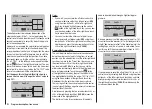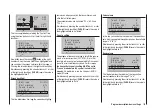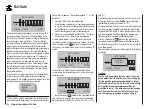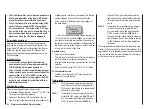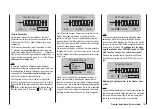
144
Program description: Telemetry menu
entered in the “TRAVEL-” and “” lines.
Select “00” if no mixer is to be set.
TRAVEL–/+ (mixer ratio in %)
The mixer ratio in relation to the MASTER signal is
determined separately for each direction by the values
entered in these two lines.
RX WING MIXER TAIL TYPE
The following model types are also available in the
“Tail” line of the “
Base settings
” menu (see page 76),
and should normally be set up at that point. If you have
done this, you should
always
leave the TAIL TYPE at
NORMAL.
However, if you prefer to use the receiver’s integral
mixers, you can select the pre-set mixer function for the
corresponding model type:
NORMAL
•
This setting corresponds to the classic aircraft type
with tail-mounted stabiliser panels and separate rud-
der and elevator. No mixer function is required for this
model type.
V-TAIL
•
For this model type the control functions elevator and
rudder are linked together in such a way that each of
the two control surfaces - actuated by a separate ser-
vos - carries out superimposed elevator and rudder
functions.
The servos are usually connected to the receiver as
follows:
OUTPUT CH 3: left V-tail servo
OUTPUT CH 4: right V-tail servo
If you find that the servos rotate in the wrong direc-
tion, please see the notes on page 62.
ELEVON (delta / flying wing models)
•
The servos connected to outputs 2 and 3 assume su-
perimposed aileron and elevator functions. The ser-
vos are usually connected to the receiver as follows:
OUTPUT CH 2: left elevon
OUTPUT CH 3: right elevon
If you find that the servos rotate in the wrong direc-
tion, please see the notes on page 62.
RX CURVE
RX CURVE
TYPE : B
CURVE1 CH : 02
TYPE : B
CURVE2 CH : 03
TYPE : B
CURVE3 CH : 04
Value
Explanation
Possible settings
CURVE1, 2
or 3 CH
Channel assign-
ment of the selec-
ted curve setting
1 … according to
receiver
TYPE
Curve type
A, B, C
see illustration
Ser
vo tr
av
el
Transmitter control travel
Expo = +100%
–100%
+100%
0
–100%
+100%
0
Ser
vo tr
av
el
Transmitter control travel
Expo = –100%
TYPE
A
–100%
+100%
0
–100%
+100%
0
Ser
vo tr
av
el
Transmitter control travel
linear
–100%
+100%
0
–100%
+100%
0
TYPE
B
TYPE
C
DR = 125%
DR = 70%
In most cases a non-linear control function is used for
aileron (channel 2), elevator (channel 3) and rudder
(channel 4), and the default settings assume that this is
the case. BUT CAUTION: this assignment only applies if
you have not set either “2 ELE Sv” in the “Tail” line of the
“
Base settings
” menu, or “2AIL” or “2AIL 2FL” in the “Ail
/ flap” line, at the transmitter. Otherwise
control function
3 (elevator)
is already split over
control channels 3 +
8
, and
control function 2 (aileron)
is split over
control
channels 2 + 5 for the left and right ailerons
. In both
these cases the corresponding
receiver control channels
(INPUT CH)
would then be channels 03 + 08 or 02 + 05.
For example, if you have set “2AIL” at the transmitter,
and wish to use the RX CURVE option discussed here
instead of the “
D/R Expo
mx-16
HoTT transmitter - which offers more individual
adjustment options - then two curves must be set:
RX CURVE
TYPE : A
CURVE1 CH : 02
TYPE : A
CURVE2 CH : 05
TYPE : B
CURVE3 CH : 04
If you ignored this, the left and right ailerons would
exhibit different control characteristics.
The RX CURVE function can be used to manage the
control characteristics for up to three servos:
CURVE 1, 2 or 3 CH
•
Select the desired control channel (INPUT CH) for
the first servo.
The following setting in TYPE only affects the chan-
nel you select at this point.
TYPE
Select the servo curve:
Summary of Contents for mx-12 Hott
Page 1: ...Programming Manual 33116 mx 16 HoTT 3 en mx 16...
Page 35: ...35 For your notes...
Page 49: ...49 For your notes...
Page 55: ...55 For your notes...
Page 59: ...59 For your notes...
Page 63: ...63 For your notes...
Page 69: ...69 For your notes...
Page 91: ...91 For your notes...
Page 101: ...101 For your notes...
Page 123: ...123 For your notes...
Page 181: ...181 For your notes...
Page 193: ...193 For your notes...

